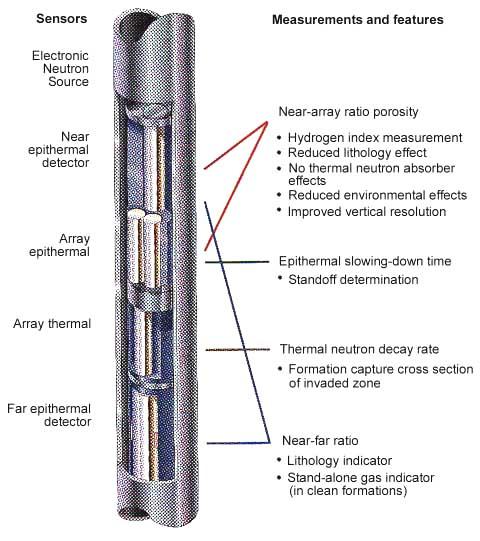Accelerator Porosity Sonde (APS*)
Description
 The APS sonde is the key module in the Integrated Porosity Lithology system components. The electronic neutron source (minitron) allows epithermal neutron measurements and detector shielding, resulting in porosity values that are less influenced by environmental conditions. The near-array ratio epithermal porosity is the primary porosity measurement. Its source-to-detector spacing is optimized to yield a formation hydrogen index measurement that is essentially free of formation matrix density effects. Five detectors provide information for porosity, gas detection, clay evaluation, improved vertical resolution and borehole corrections.
The APS sonde is the key module in the Integrated Porosity Lithology system components. The electronic neutron source (minitron) allows epithermal neutron measurements and detector shielding, resulting in porosity values that are less influenced by environmental conditions. The near-array ratio epithermal porosity is the primary porosity measurement. Its source-to-detector spacing is optimized to yield a formation hydrogen index measurement that is essentially free of formation matrix density effects. Five detectors provide information for porosity, gas detection, clay evaluation, improved vertical resolution and borehole corrections.
Applications
Porosity. In reservoir engineering the importance of porosity measurements is quite evident. In the study of the volcanic rocks that make up the upper oceanic crust, a good in-situ porosity measurement is critical to the correct understanding of the crustal structure, for two reasons: first, because it samples both the small-scale (microcrack, vesicle) porosity seen in the cores and the large-scale fractures not sampled by drilling; and second, because other properties such as density, seismic velocity, and permeability depend strictly on porosity variations and on the geometry of the pore space. In the presence of clays or hydrous alteration minerals a correction is required to account for the presence of bound water.
Lithology. Because the hydrogen measured by the tool is present not only as free water but also as bound water in clay minerals, the porosity curve, often combined with the density log, can be used to detect shaly intervals, or minerals such as gypsum, which has a high hydrogen index due to its water of crystallization. Conversely, the neutron curve can be used to identify anhydrite and salt layers (which are both characterized by low neutron readings and by high and low bulk density readings respectively).
Environmental Effects
Eccentralization of the tool by a bow spring is the most important requirement to obtain reliable porosity measurements. The triple combo string utilizes an in-line eccentralizer to maintain consistent contact with the borehole wall. The eccentralizer is vital in preventing poor contact of the tool with the borehole wall, which can lead to attenuation of the formation signal by the borehole fluid and, in turn, the overestimation of the true porosity of the formation.
Hole size also affects the neutron log response; the formation signal, particularly for the epithermal count rates, tends to be masked by the borehole signal with increasing hole size.
In liquid-filled holes the influence of the borehole fluid depends on its salinity — chlorine is a strong neutron absorber — and density: the addition of weighting additives such as barite will yield a lower porosity reading. When the neutron tool is run through the drilling pipe and bottom hole assembly, the recordings should be used with caution. Because iron is a strong neutron absorber, an increased porosity reading will result, its degree depending on the thickness of the pipe.
Tool Specifications
| Temperature rating: | 350° F (175° C) |
| Pressure rating: | 20 kpsi (138 MPa) |
| Length: | 13 ft (3.96 m) |
| Weight: | 222 lbs (100.8 kg) |
| Diameter: | 3.625 in (9.2 cm) |
| Sampling interval: | 6 in (15.24 cm); 2 in (5.08 cm) |
| Maximum logging speed: | 1,800 ft/hr (548 m/hr) |
Measurement Specifications
| Vertical resolution: | 14 in (35.56 cm) |
| Depth of investigation: | 7 in (17.78 cm) |
| Epithermal porosity: | Row 3, Col 2 |
| 0-7 pu: | ±0.5 pu |
| 7-30 pu: | ±7% |
| 30-60 pu: | ±10% |
Major Outputs
| APLC: | Near/array limestone porosity corrected (pu) |
| STOF: | Computed standoff (in) |
| SIGF: | Formation capture cross section (cu) |
| FEC: | Far detector count rate (cps) |
| ANEC: | Near detector count rate (cps)Row 5, Col 2 |
Deployment Notes
- The APS is typically run with the HRLA/DIT, HLDS, and HNGS tools.
* ®trademark of Schlumberger
